Analysis of the Guide Vane Jet-Vortex Flow and the Induced Noise in a Prototype Pump-Turbine
Abstract
Featured Application
Abstract
1. Introduction
2. Pump-Turbine Unit
2.1. Parameters of Pump-Turbine
2.2. Studied Condition
3. Mathematical Modeling
3.1. Governing Equations
3.2. Turbulence Modeling
3.3. Acoustic Analogy Method
4. CFD Setup
- A velocity inlet boundary was given at the draft tube inflow with uniformly distributed value.
- A static pressure outlet boundary of 0 Pa was given at the volute outflow.
- No-slip wall boundaries were given on all the solid walls.
- Interfaces were set for connecting different domains based on the general grid interface method. The “frozen rotor” type was used for the rotor-stator interface in steady state simulations. The “transient rotor stator” type was used for transient simulations.
5. Results and Analysis
5.1. Reference Positions for Post-Processing
5.2. Internal Flow Regime
5.3. Instaneous Turbulent-Flow-Induced Noise Field
5.4. Turbulence Kinetic Energy Pulsation
5.5. Propagation of Frequency
- fb = 64.5 Hz: (a) Between runner and guide vane; (b) in the guide vane jet;
- fgsv = 9.6 Hz: (a) In the stay vane and guide vane channels; (b) near volute vortex; (c) in the guide vane jet;
- fvl = 3.2 Hz: (a) Near volute vortex; (b) on the back side of stay vane blade; (c) in the guide vane jet.
5.6. Checking the Effectiveness of DES
6. Conclusions
- (1)
- In a pump-turbine’s start-up process in pump mode, flow regime is undesirable due to a small guide vane opening angle. In this study at Cφ = 0.015 and α = 3 degrees, the jet-vortex flow structure can be observed in the diffuser, including the guide vane, stay vane, and volute. It consists of Ⅰ—the flow ring between the runner trailing-edge and the guide vane, Ⅱ—the guide vane jet, Ⅲ and Ⅳ—the twin-vortexes adjacent to guide vane jet, Ⅴ—the inter stay vane vortex, Ⅵ —the stay vane jet, and Ⅶ—the volute vortex-ring. These jets and vortexes interfere with the runner pumping and cause an instability of the flow field.
- (2)
- Based on the acoustic analogy method, strong noise can be found in the jet-vortex flow structure. Results show that the high turbulence kinetic energy and eddy dissipation caused by undesirable flow structures could be the reason why noise is generated in the flow passages. High sound power level Lsp regions in the jets and vortexes are caused by high turbulence kinetic energy. High Lsp regions on the blade leading-edges are due to local flow striking and separation with strong eddy dissipation. The strongest Lsp region is in the guide vane jet, where Lsp is up to about 150 dB. This shows that the guide vane opening and direction are the most important factors in inducing noise, especially at small guide vane opening angle conditions.
- (3)
- The pulsation of turbulence kinetic energy coefficient Ck was studied on monitoring points P1 to P7. Three specific frequencies were found, including the runner blade frequency fb = 64.5 Hz, the dominate frequency in the guide vane and stay vane fgsv = 9.6 Hz, and the dominate frequency in the volute fvl = 3.2 Hz. The 18 × 18 flow pulsation tracing topology gives a better visualization of frequency distribution and propagation. The frequency-dominated turbulence kinetic energy coefficient Ck* was used instead of Ck to exclude the pulsation amplitude difference. Results show that different specific frequencies are caused by different flow structures. Frequencies will propagate and affect the adjacent regions.
Author Contributions
Funding
Acknowledgments
Conflicts of Interest
Nomenclature
| C1 | the studied condition Cφ = 0.015 and Cα = 0.096 | nq | specific speed |
| CDES | model constant of DES | P | production term in turbulence model |
| Ck | turbulence kinetic energy coefficient | P1~P7 | monitoring points for flow field pulsation |
| Ck* | frequency-dominated Ck | Q | flow rate |
| CkRMS | RMS amplitude value of specific frequency | Qd | flow rate at best efficiency point |
| Cv | velocity coefficient | R | radial direction |
| Cα | relative guide vane opening angle | Rhi | radius at runner high pressure side |
| Cε | eddy dissipation rate coefficient | Rlowh | radius at runner low pressure side at hub |
| Cφ | flow rate coefficient | Rlows | radius at runner low pressure side at shroud |
| CφBEP | flow rate coefficient at best efficiency point | SA, SB | reference surfaces for flow analysis |
| Cω | production term coefficient in turbulence model | mean rate of strain tensor | |
| F1 | blending function of SST model | t | time |
| f2 | a specific frequency | u | velocity |
| fb | runner blade frequency | Uhi | rotational linear velocity at Rhi |
| fgsv | dominate frequency in guide vane and stay vane | Vc | sound speed in fluid medium |
| fvl | dominate frequency in volute | Vrel | relative velocity |
| g | acceleration of gravity | WA | turbulent-flow-induced sound power |
| Hd | head at best efficiency point | Wref | reference sound power |
| k | turbulence kinetic energy | x | coordinate component |
| lk-ω | turbulence scale | X, Y, Z | orthogonal coordinate components |
| Lsp | turbulent-flow-induced sound power level | y+ | dimensionless height off-wall |
| nd | runner rotation speed |
| αε | constant in acoustic analogy method | BEP | best efficiency point |
| βk | model constant of SST model | CA | computational acoustic |
| ΔCk | peak-peak value of Ck | CFD | computational fluid dynamics |
| δij | Kroneker delta | DES | detached eddy simulation |
| Δm | mesh length scale | DT | draft tube |
| ΔR | radial interval in pulsation tracing topology | FFT | fast-Fourier transformation |
| Δx/y/z | side length of mesh element | GCI | grid convergence index |
| Δθ | tangential interval in pulsation tracing topology | GV | guide vane |
| ε | eddy dissipation rate | LES | large-eddy simulation |
| η | efficiency | MRF | multiple reference frame |
| θ | tangential direction | RANS | Reynolds-averaged Navier-Stokes |
| μ | dynamic viscosity | RMS | root-mean-square |
| μt | eddy viscosity | RN | runner |
| ρ | density | RSI | rotor stator interaction |
| σk | model constant of SST model | SST | shear stress transport |
| σω | model constant of SST model | SV | stay vane |
| ω | rotational angular speed | VL | volute |
References
- Oishi, A.; Yokoyama, T. Development of high head single and double stage reversible pump-turbines. In Proceedings of the 10th IAHR Symposium on Hydraulic Machinery and Cavitation, Tokyo, Japan, 28 September–2 October 1980. [Google Scholar]
- Mei, Z. Technology of Pumped-Storage Power Generation; China Machine Press: Beijing, China, 2000. [Google Scholar]
- Rodriguez, C.G.; Mateosprieto, B.; Egusquiza, E. Monitoring of rotor-stator interaction in pump-turbine using vibrations measured with on-board sensors rotating with shaft. Shock Vib. 2014, 276796. [Google Scholar] [CrossRef]
- Hasmatuchi, V.; Farhat, M.; Roth, S.; Botero, F.; Avellan, F. Experimental evidence of rotating stall in a pump-turbine at off-design conditions in generating mode. J. Fluids Eng. 2011, 133, 051104. [Google Scholar] [CrossRef]
- Zhang, Y.; Zhang, Y.; Wu, Y. A review of rotating stall in reversible pump turbine. Proc. Inst. Mech. Eng. Part C J. Mech. Eng. Sci. 2017, 231, 1181–1204. [Google Scholar] [CrossRef]
- Zuo, Z.; Liu, S.; Sun, Y.; Wu, Y. Pressure fluctuations in the vaneless space of High-head pump-turbines—A review. Renew. Sustain. Energy Rev. 2015, 41, 965–974. [Google Scholar] [CrossRef]
- Li, Z.; Bi, H.; Karney, B.; Wang, Z.; Yao, Z. Three-dimensional transient simulation of a prototype pump-turbine during normal turbine shutdown. J. Hydraul. Res. 2017, 55, 520–537. [Google Scholar] [CrossRef]
- Review and outlook of studying on noise of centrifugal pumps. J. Vib. Shock 2011, 30, 77–84.
- Govern, C.C.; TenWolde, P.R. Energy dissipation and noise correlations in biochemical sensing. Phys. Rev. Lett. 2014, 113, 258102. [Google Scholar] [CrossRef]
- Bernd, D.; Wurm, F.H. Noise sources in centrifugal pumps. In Proceedings of the 2nd WSEAS International Conference on Applied and Theoretical Mechanics, Venice, Italy, 20–22 November 2006. [Google Scholar]
- Langthjem, M.A.; Olhoff, N. A numerical study of flow-induced noise in a two-dimensional centrifugal pump. Part II. Hydroacoustics. J. Fluids Struct. 2004, 19, 369–386. [Google Scholar] [CrossRef]
- Chudina, M. Noise as an indicator of cavitation in a centrifugal pump. Acoust. Phys. 2003, 49, 463–474. [Google Scholar] [CrossRef]
- Curle, N. The influence of solid boundaries upon aerodynamic sound. Proc. R. Soc. Lond. Ser. A Math. Phys. Sci. 1955, 231, 505–514. [Google Scholar]
- Ffowcs-Williams, J.E.; Hawkings, D.L. Sound generation by turbulence and surfaces in arbitrary motion. Math. Phys. Sci. 1969, 264, 321–342. [Google Scholar] [CrossRef]
- Goldstein, J.L. An optimum processor theory for the central formation of the pitch of complex tones. J. Acoust. Soc. Am. 1973, 54, 1496–1516. [Google Scholar] [CrossRef] [PubMed]
- Lighthill, M.J. On sound generated aerodynamically, II. Turbulence as a source of sound. Proc. R. Soc. Lond. Ser. A 1954, 222, 1–32. [Google Scholar]
- Chu, S.; Dong, R.; Katz, J. Relationship between unsteady flow, pressure fluctuations, and noise in a centrifugal pump, part B: Effects of blade-tongue interaction. J. Fluids Eng. 1995, 117, 30–35. [Google Scholar] [CrossRef]
- Srivastav, O.P.; Pandu, K.R.; Gupta, K. Effect of radial gap between impeller and diffuser on vibration and noise in a centrifugal pump. J. Inst. Eng. Mech. Eng. Div. 2003, 84, 36–39. [Google Scholar]
- Sun, X.; Hu, Z.; Feng, Y.; Zhou, S. An aeroacoustic model about the rotating stall of a compressor. Acta Aeronaut. Astronaut. Sin. 1991, 12, A467–A473. [Google Scholar]
- Mongeau, L.; Thompson, D.E.; Mclaughlin, D.K. Sound generation by rotating stall in centrifugal turbomachines. J. Sound Vib. 1993, 163, 1–30. [Google Scholar] [CrossRef]
- Bogey, C.; Marsden, O.; Bailly, C. Large-eddy simulation of the flow and acoustic fields of a Reynolds number 105 subsonic jet with tripped exit boundary layers. Phys. Fluids 2011, 23, 035104. [Google Scholar] [CrossRef]
- Canepa, E.; Cattanei, A.; Zecchin, F.M.; Milanese, G.; Parodi, D. An experimental investigation on the tip leakage noise in axial-flow fans with rotating shroud. J. Sound Vib. 2016, 375, 115–131. [Google Scholar] [CrossRef]
- Brooks, T.F.; Hodgson, T.H. Trailing edge noise prediction from measured surface pressures. J. Sound Vib. 1981, 78, 69–117. [Google Scholar] [CrossRef]
- Wang, W.; Thomas, P.J. Acoustic improvement of stator–rotor interaction with nonuniform trailing edge blowing. Appl. Sci. 2018, 8, 994. [Google Scholar] [CrossRef]
- Proudman, I. The generation of noise by isotropic turbulence. Proc. R. Soc. Lond. Ser. A Math. Phys. Sci. 1952, 214, 119–132. [Google Scholar]
- Tao, R.; Zhao, X.; Wang, Z. Evaluating the transient energy dissipation in a centrifugal impeller under rotor-stator interaction. Entropy 2019, 21, 271. [Google Scholar] [CrossRef]
- Liu, J.; Wang, L.; Liu, S.; Sun, Y.; Wu, Y. Three dimensional flow simulation of load rejection of a prototype pump-turbine. Eng. Comput. 2013, 29, 417–426. [Google Scholar]
- Nennemann, B.; Parkinson, É. Yixing pump turbine guide vane vibrations: Problem resolution with advanced CFD analysis. IOP Conf. Ser. Earth Environ. Sci. 2010, 12, 012057. [Google Scholar] [CrossRef]
- Zhu, D.; Xiao, R.; Tao, R.; Liu, W. Impact of guide vane opening angle on the flow stability in a pump-turbine in pump mode. Proc. Inst. Mech. Eng. Part C J. Mech. Eng. Sci. 2017, 231, 2484–2492. [Google Scholar] [CrossRef]
- Li, D.; Gong, R.; Wang, H.; Han, l.; Wei, X.; Qin, D. Analysis of vorticity dynamics for hump characteristics of a pump turbine model. J. Mech. Sci. Technol. 2016, 30, 3641–3650. [Google Scholar] [CrossRef]
- Tao, R.; Xiao, R.; Wang, F.; Liu, W. Cavitation behavior study in the pump mode of a reversible pump-turbine. Renew. Energy 2018, 125, 655–667. [Google Scholar] [CrossRef]
- Gentner, C.; Sallaberger, M.; Widmer, C.; Braun, O.; Staubli, T. Numerical and experimental analysis of instability phenomena in pump turbines. IOP Conf. Ser. Earth Environ. Sci 2012, 15, 032042. [Google Scholar] [CrossRef]
- Liu, J.; Liu, S.; Wu, Y.; Sun, Y.; Zuo, Z. Prediction of “S” characteristics of a pump-turbine with small opening based on V2F model. Int. J. Mod. Phys. Conf. Ser. 2012, 19, 417–423. [Google Scholar] [CrossRef]
- Spalart, P.R. Detached-eddy simulation. Annu. Rev. Fluid Mech. 2009, 41, 181–202. [Google Scholar] [CrossRef]
- Menter, F.R. Two-Equation Eddy-Viscosity Turbulence Models for Engineering Applications. AIAA J. 1994, 32, 1598–1605. [Google Scholar] [CrossRef]
- Liu, H.; Tan, M. Modern Design Methods for Centrifugal Pumps; China Machine Press: Beijing, China, 2013. [Google Scholar]
- Celik, I.; Ghia, U.; Roache, P.J.; Freitas, C.J.; Coloman, H.; Raad, P.E. Procedure of estimation and reporting of uncertainty due to discretization in CFD applications. J. Fluids Eng. 2008, 130, 078001. [Google Scholar]
- Kader, B.A. Temperature and concentration profiles in fully turbulent boundary layers. Int. J. Heat Mass Transf. 1981, 24, 1541–1544. [Google Scholar] [CrossRef]
- Shankaran, G.; Dogruoz, M.B. Advances in fan modeling—Using multiple reference frame (MRF) approach on blowers. In Proceedings of the ASME 2011 Pacific Rim Technical Conference & Exposition on Packaging and Integration of Electronic and Photonic Systems, Portland, OR, USA, 6–8 July 2011. [Google Scholar]
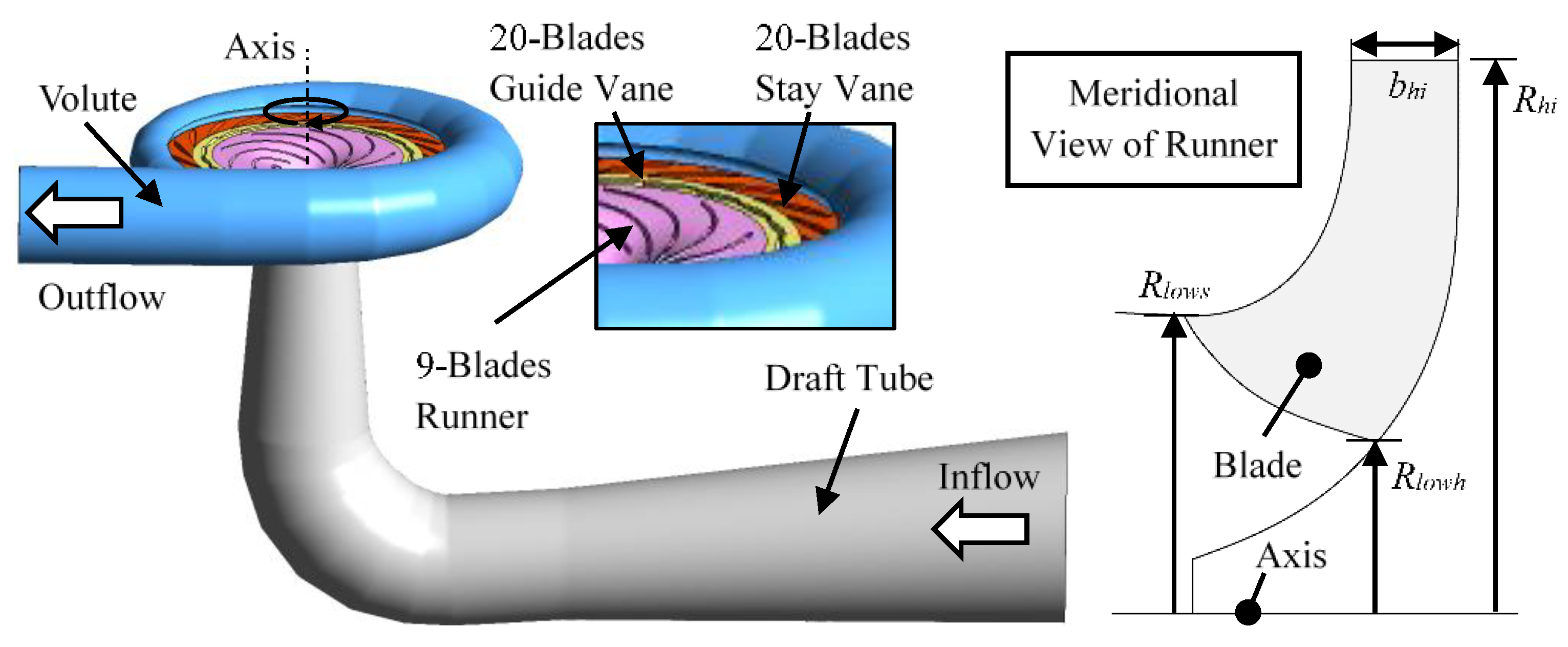
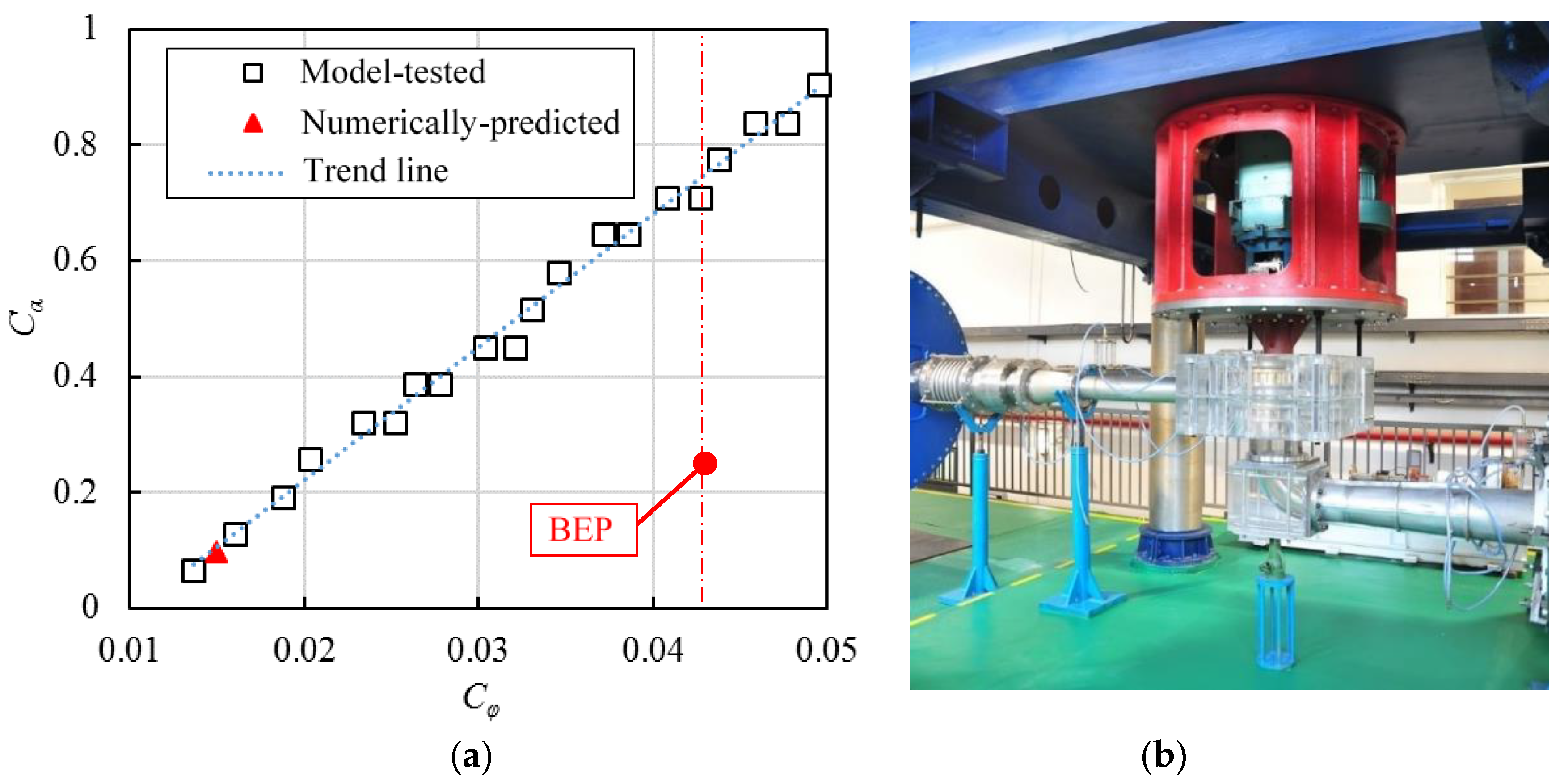
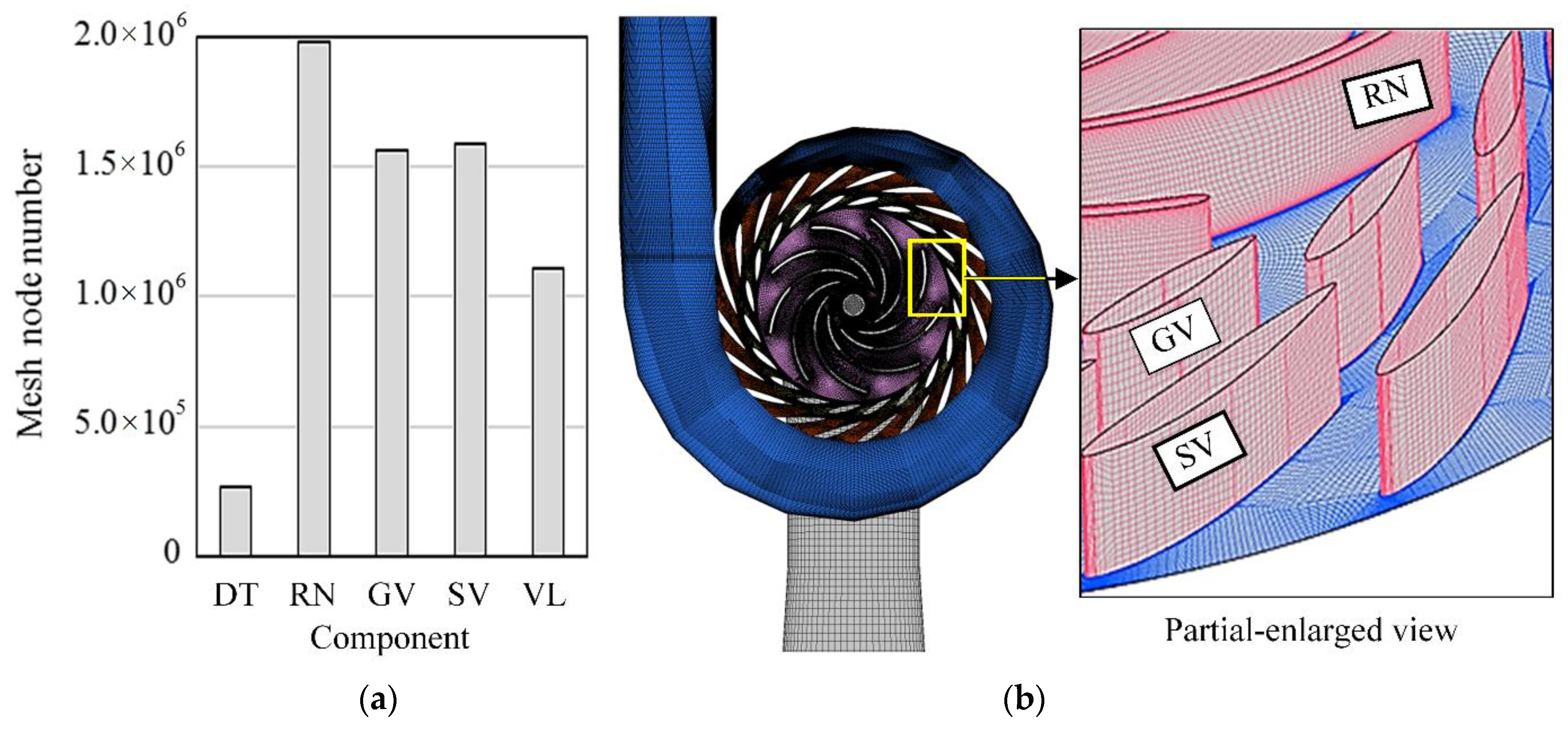
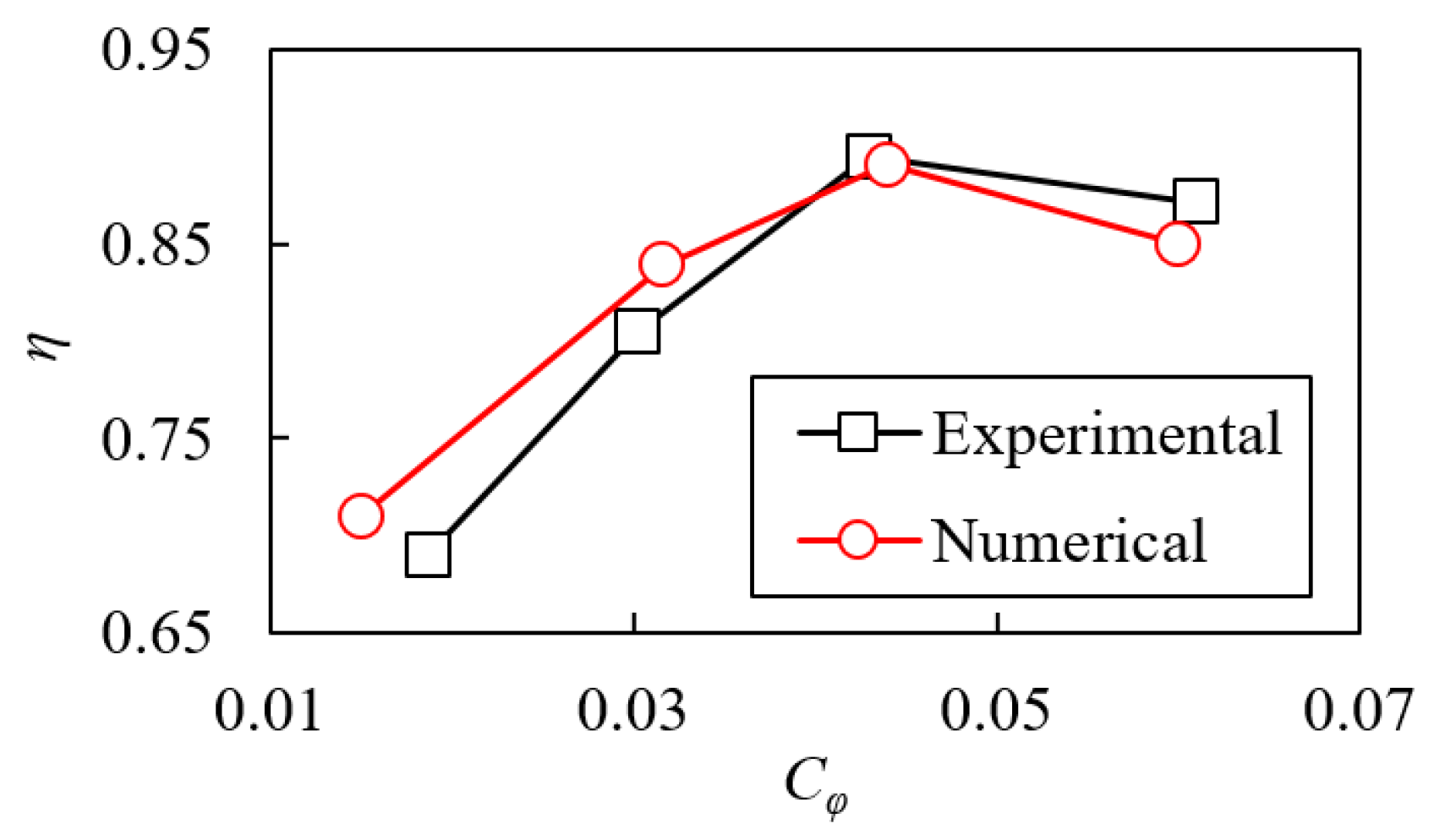
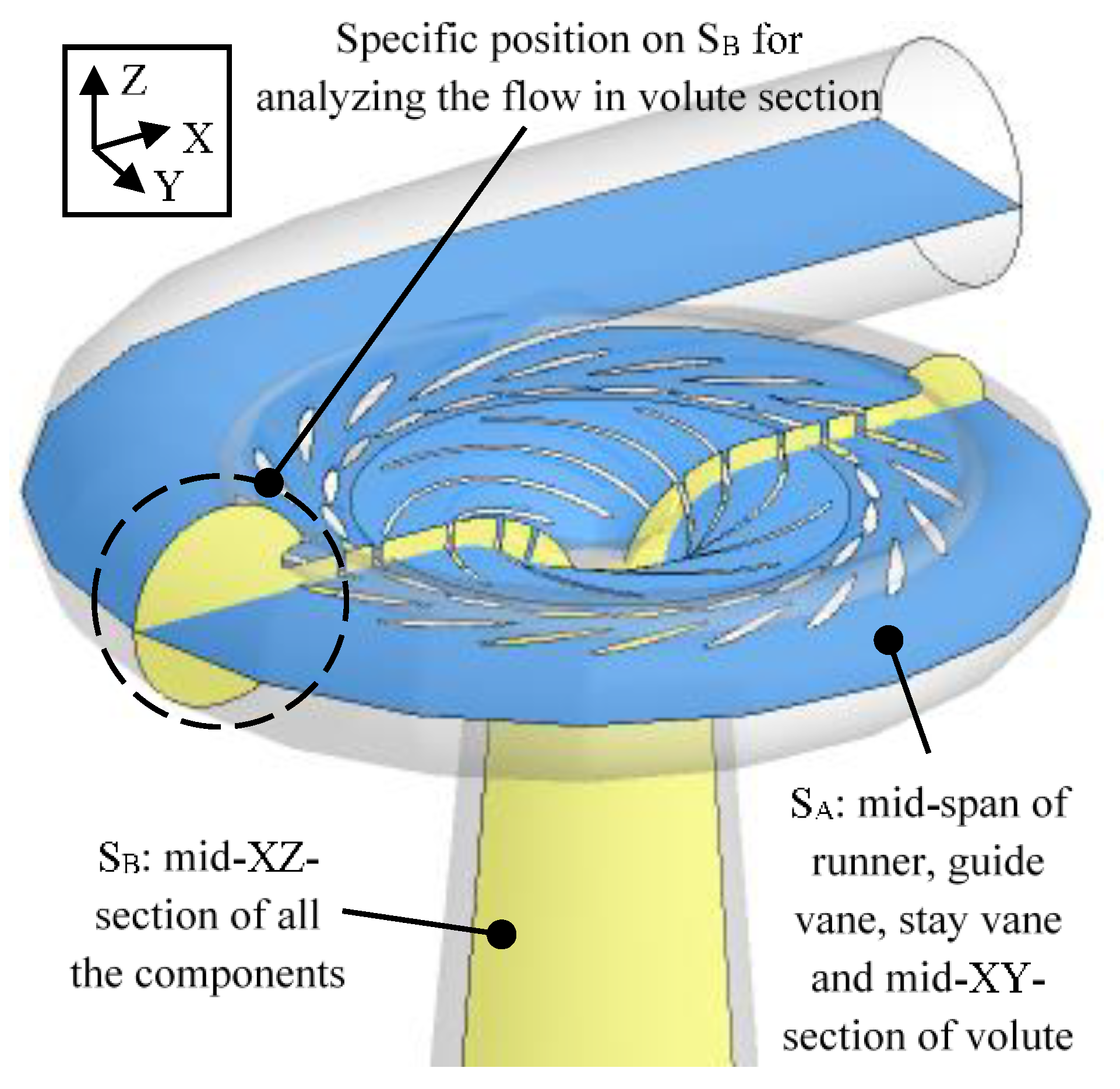
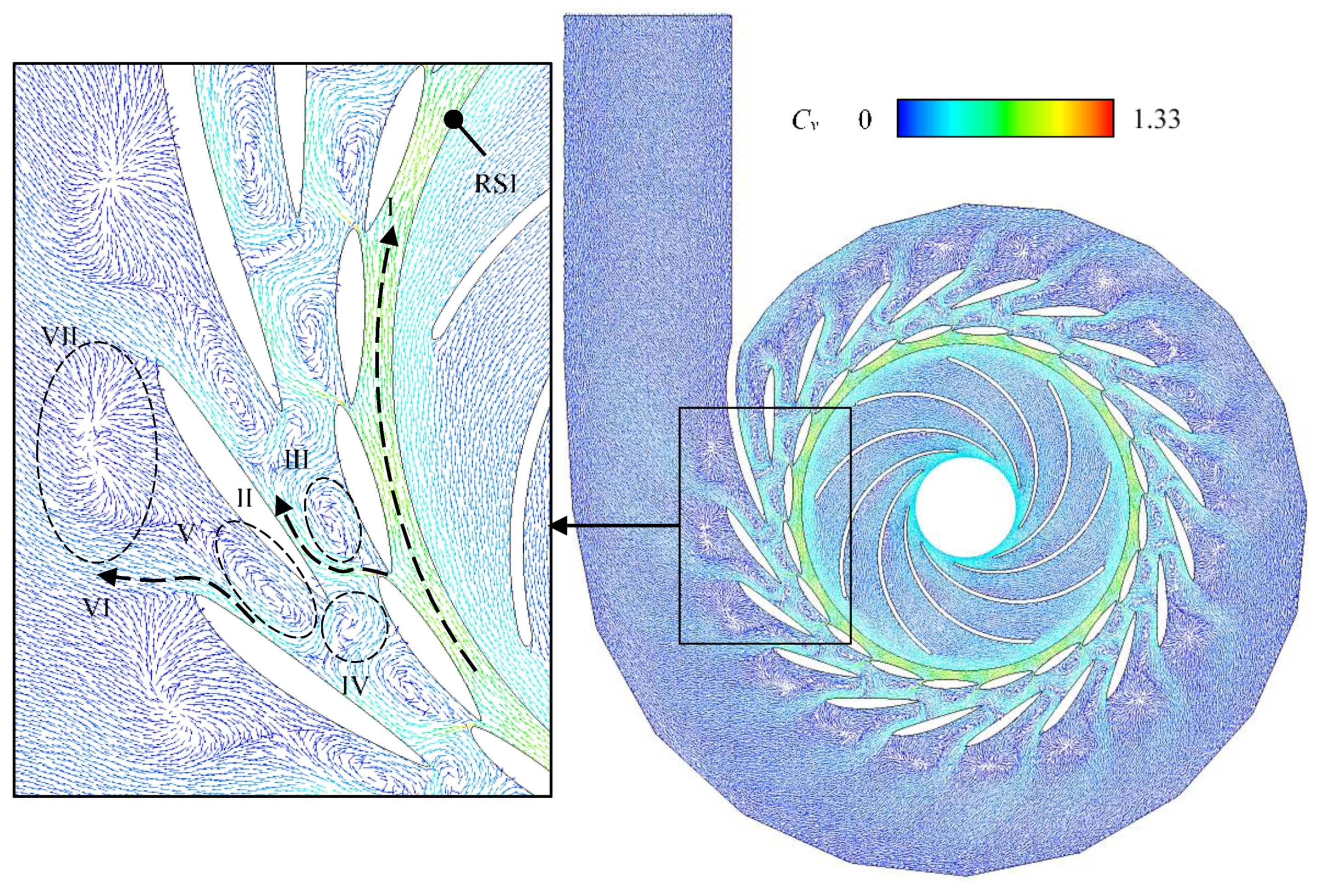
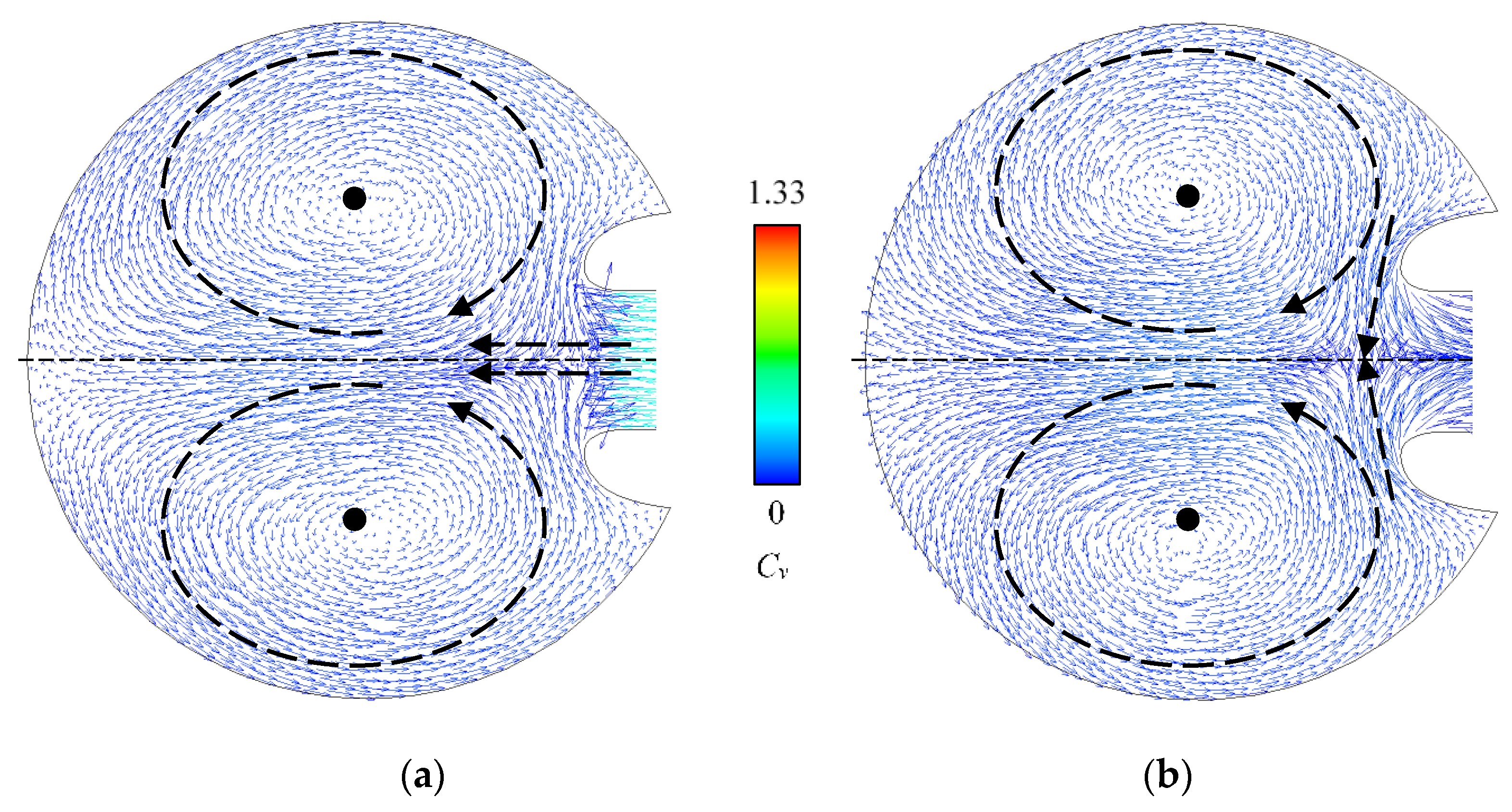
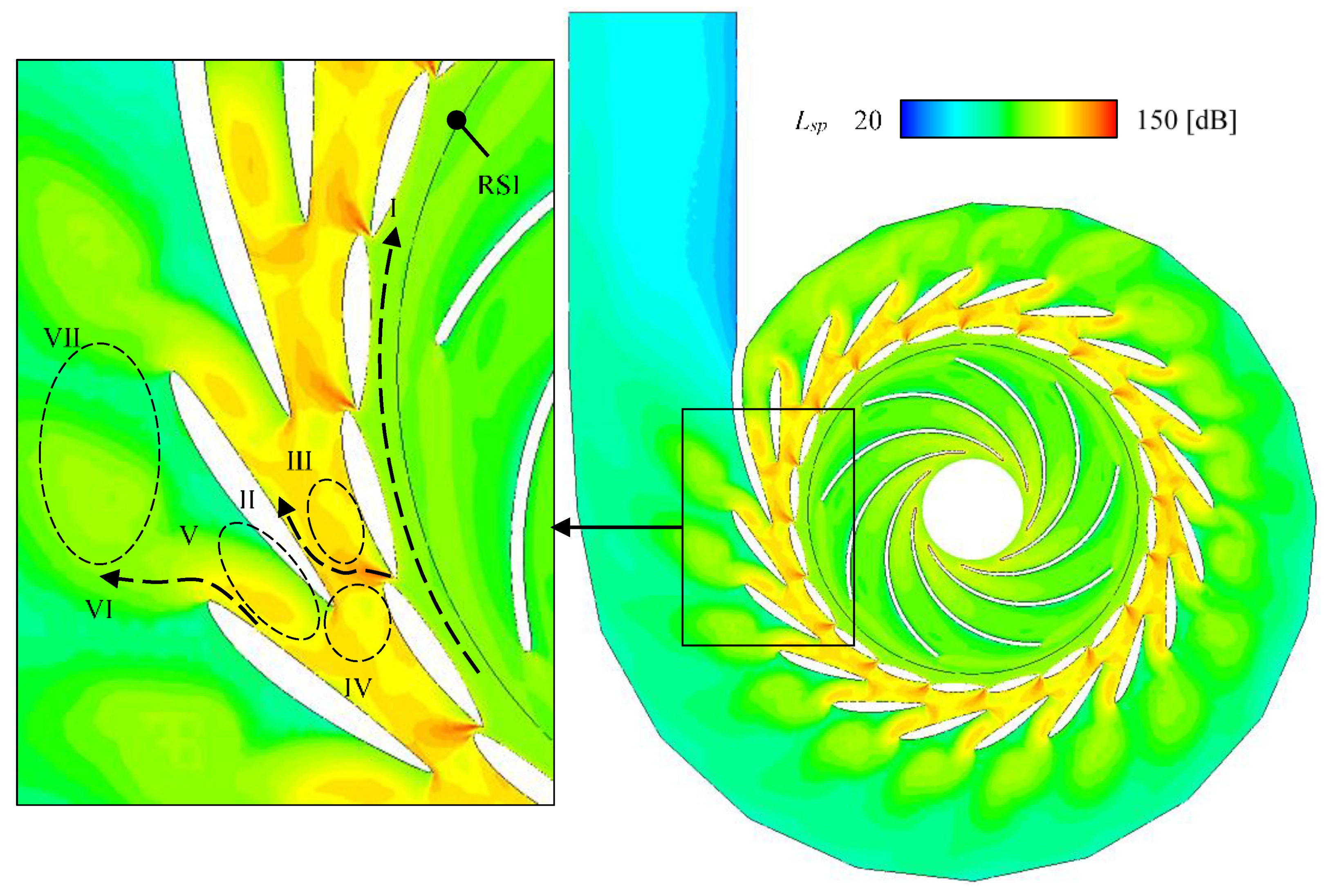
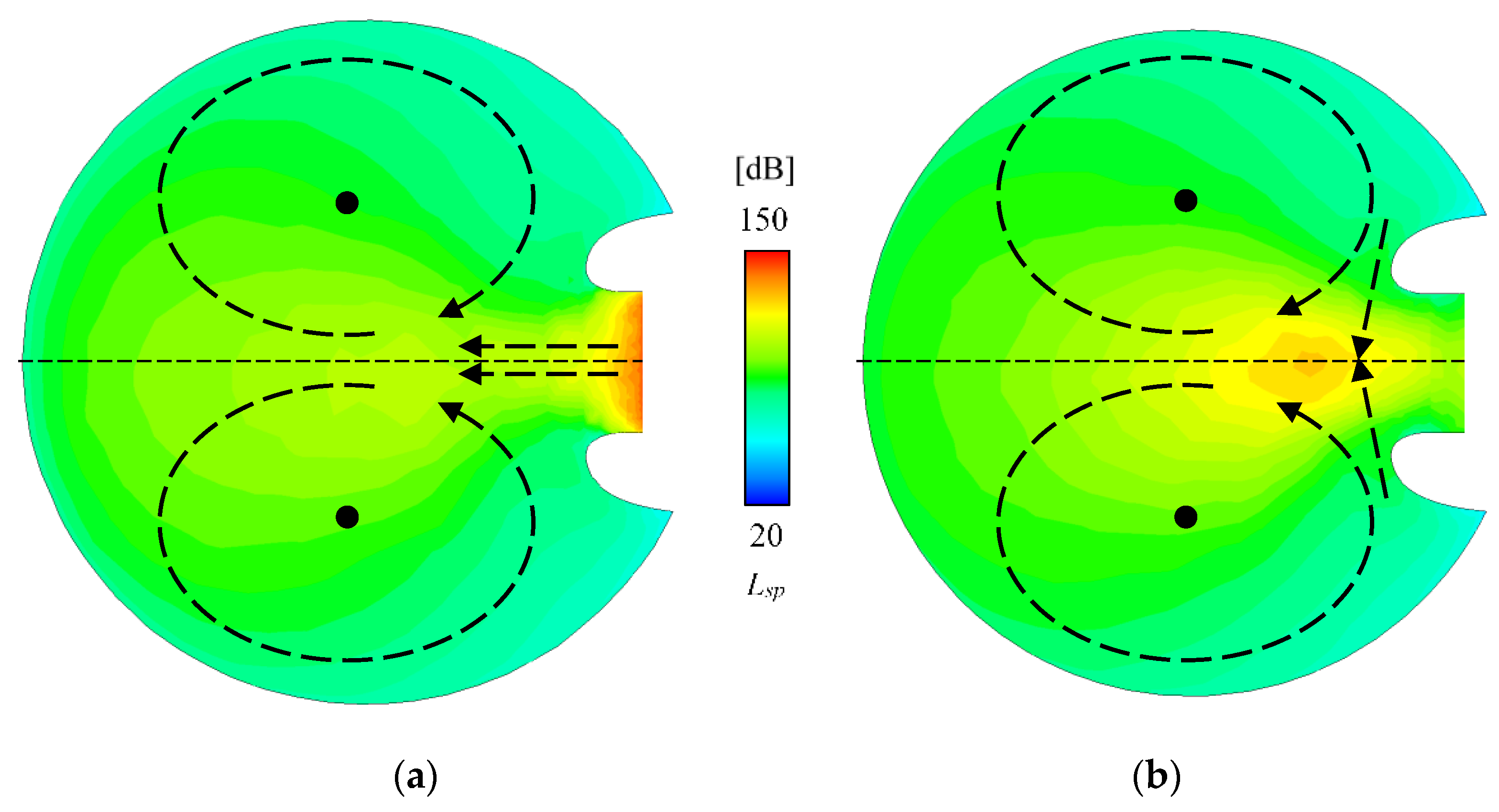
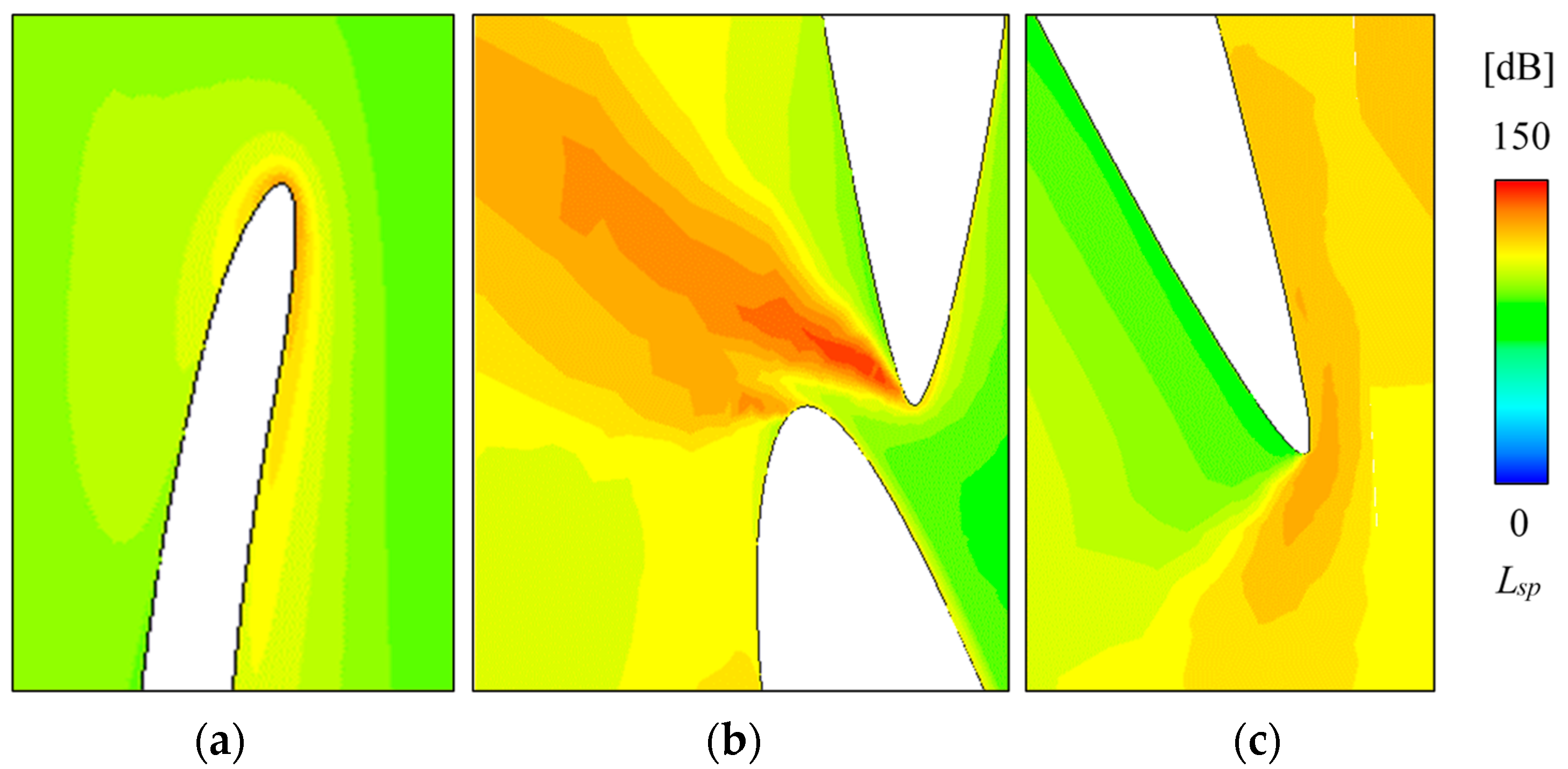
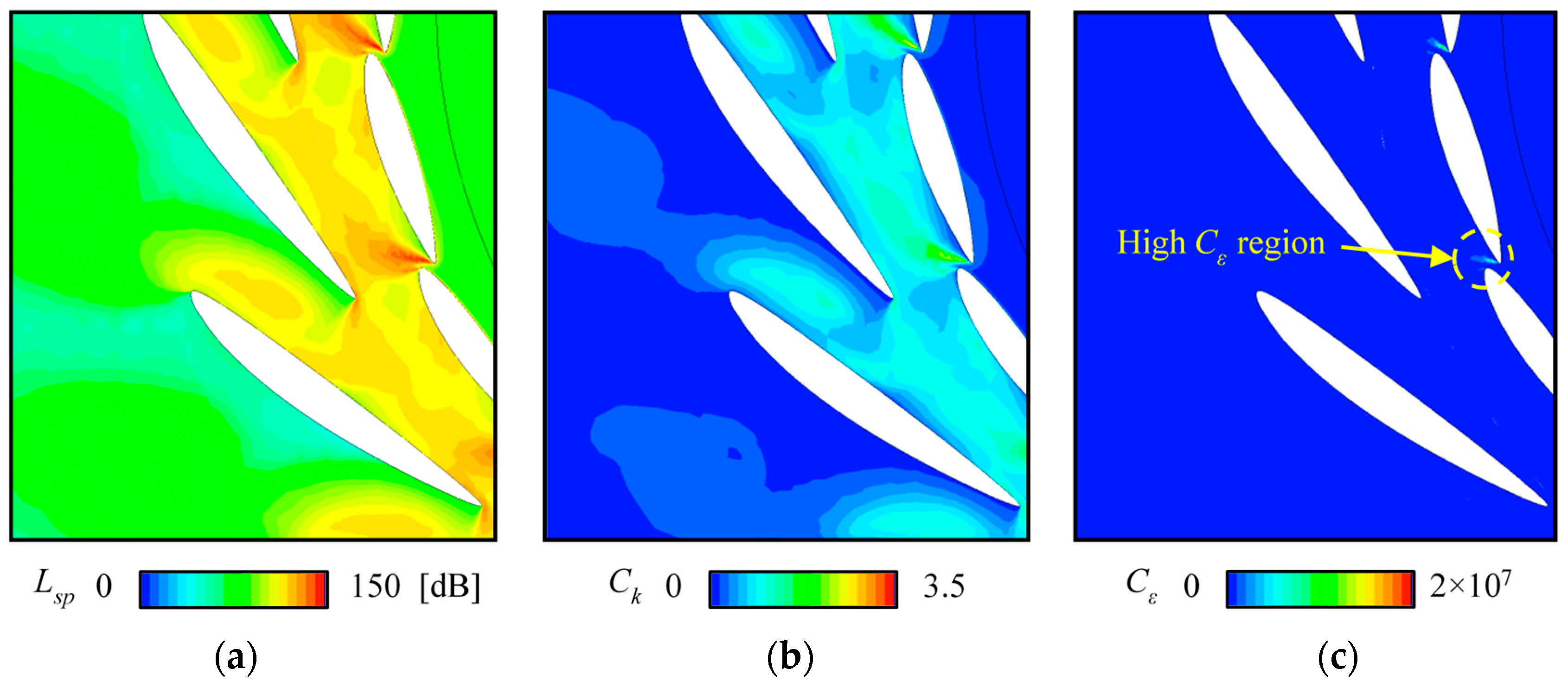
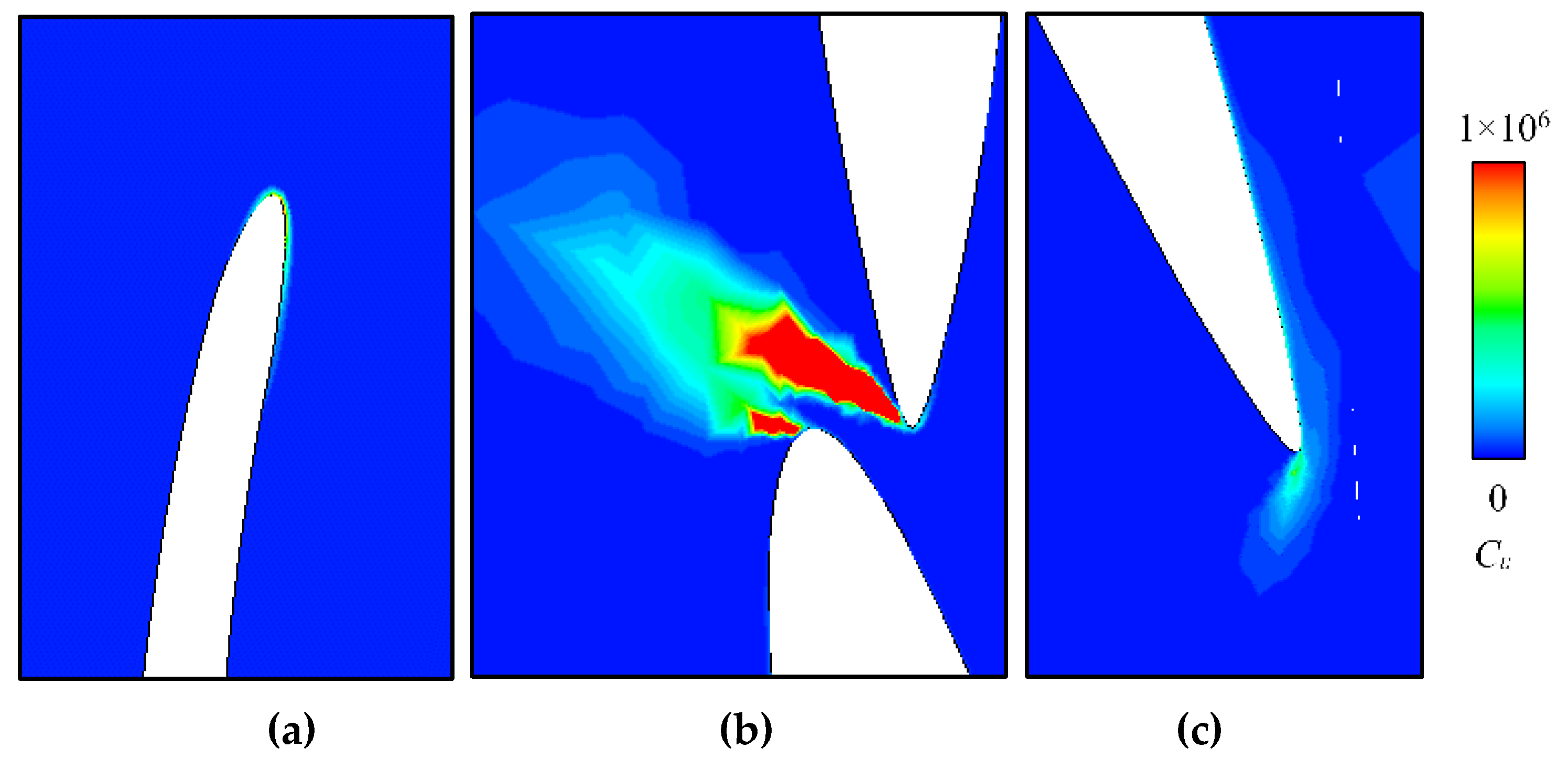
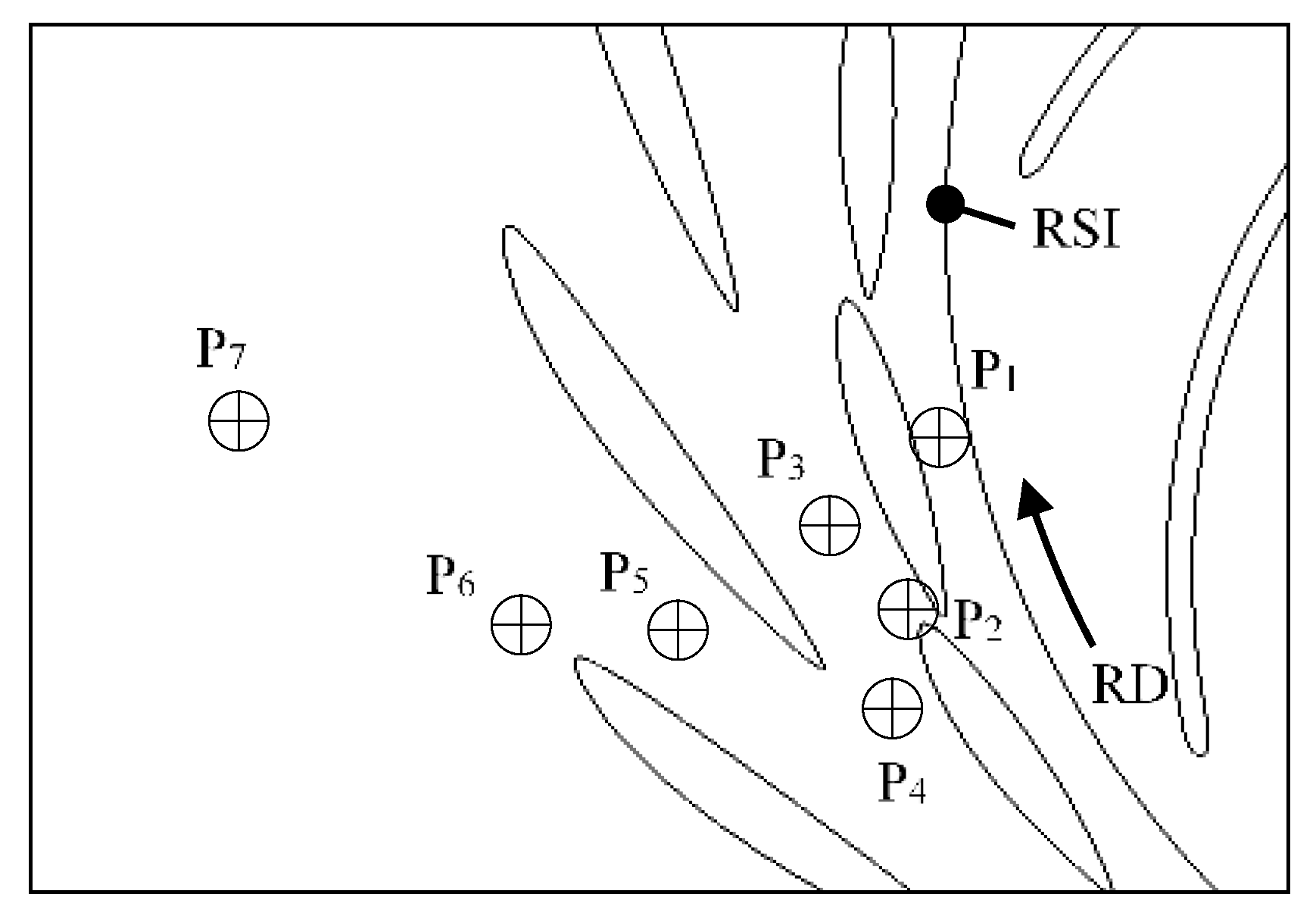







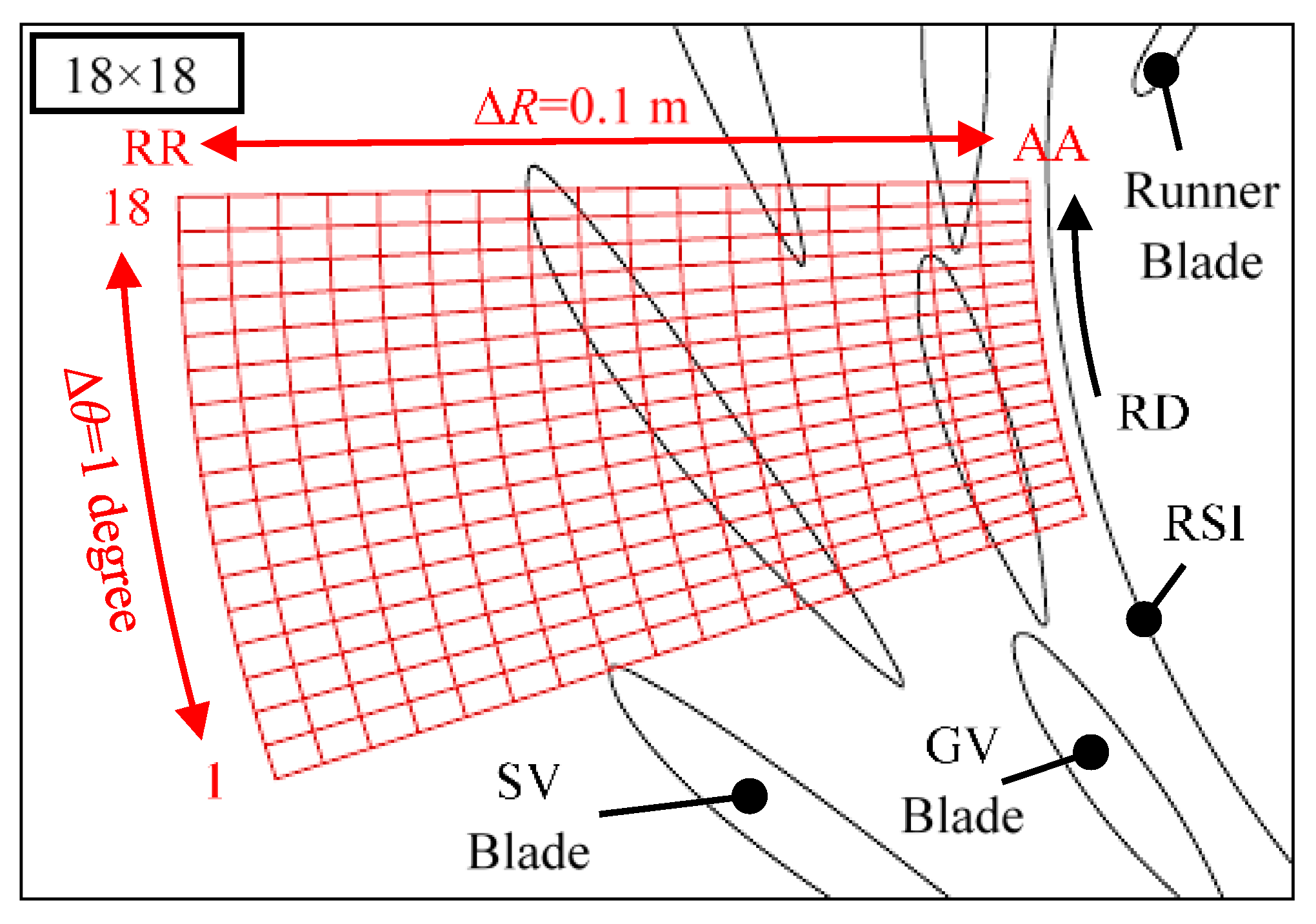
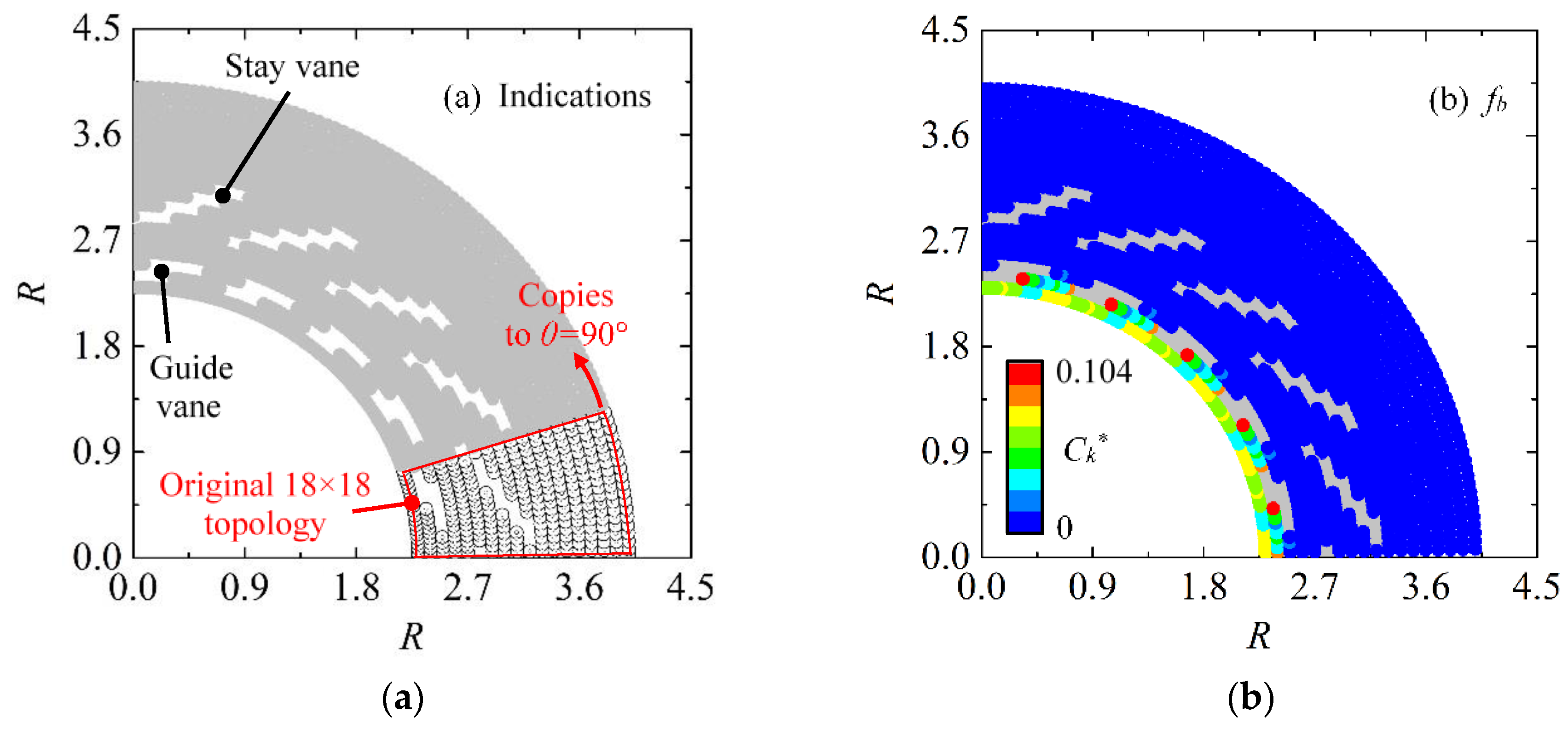
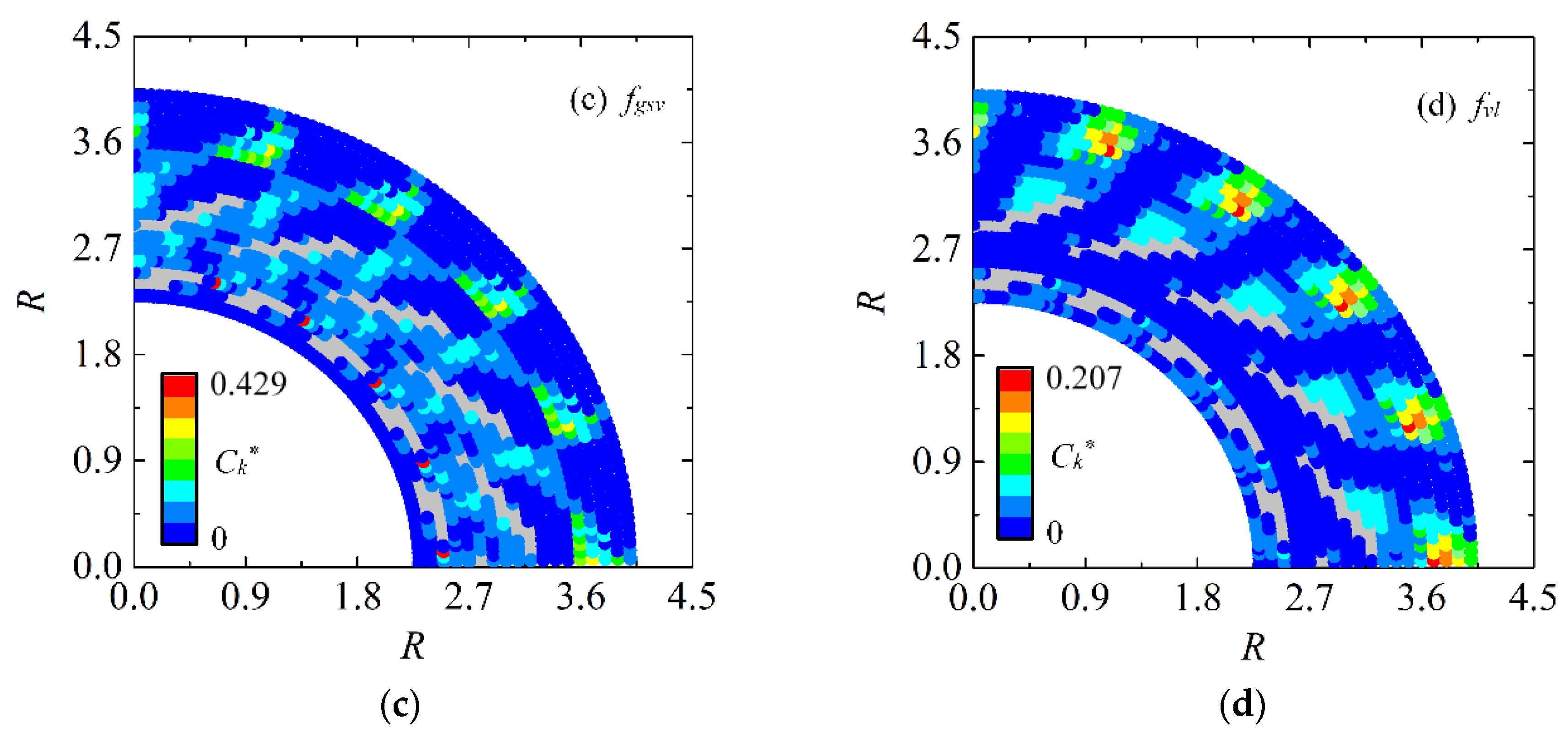
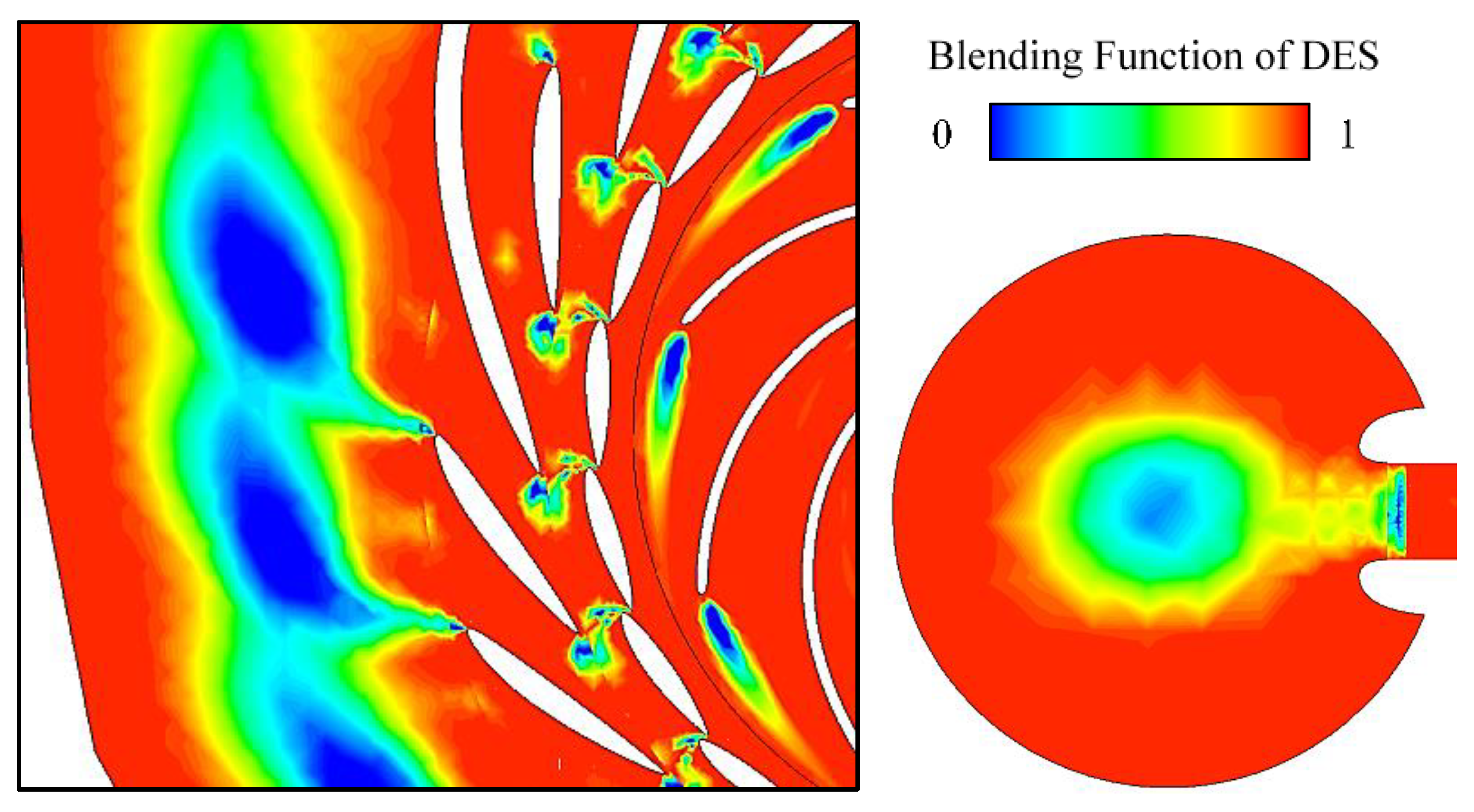
| Name | Frequency Value | Description |
|---|---|---|
| fb | 64.5 (Hz) | Runner blade frequency |
| fgsv | 9.6 (Hz) | Dominate frequency in guide vane and stay vane. fgsv = f2 |
| fvl | 3.2 (Hz) | Dominate frequency in volute fvl = 1/3 f2 |
© 2019 by the authors. Licensee MDPI, Basel, Switzerland. This article is an open access article distributed under the terms and conditions of the Creative Commons Attribution (CC BY) license (http://creativecommons.org/licenses/by/4.0/).
Share and Cite
Tao, R.; Wang, Z. Analysis of the Guide Vane Jet-Vortex Flow and the Induced Noise in a Prototype Pump-Turbine. Appl. Sci. 2019, 9, 1971. https://doi.org/10.3390/app9101971
Tao R, Wang Z. Analysis of the Guide Vane Jet-Vortex Flow and the Induced Noise in a Prototype Pump-Turbine. Applied Sciences. 2019; 9(10):1971. https://doi.org/10.3390/app9101971
Chicago/Turabian StyleTao, Ran, and Zhengwei Wang. 2019. "Analysis of the Guide Vane Jet-Vortex Flow and the Induced Noise in a Prototype Pump-Turbine" Applied Sciences 9, no. 10: 1971. https://doi.org/10.3390/app9101971
APA StyleTao, R., & Wang, Z. (2019). Analysis of the Guide Vane Jet-Vortex Flow and the Induced Noise in a Prototype Pump-Turbine. Applied Sciences, 9(10), 1971. https://doi.org/10.3390/app9101971





